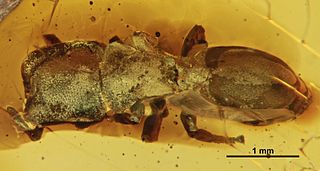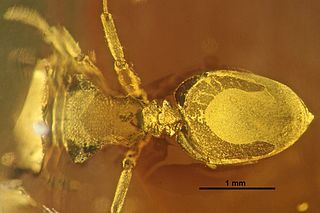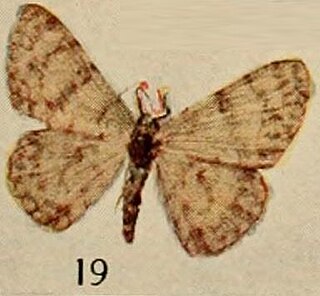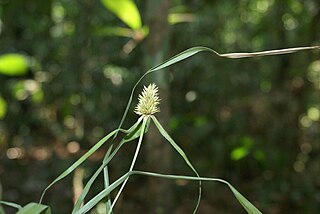
Gliding ants are arboreal ants of several different genera that are able to control the direction of their descent when falling from a tree. Living in the rainforest canopy like many other gliders, gliding ants use their gliding to return to the trunk of the tree they live on should they fall or be knocked off a branch. Gliding was first discovered for Cephalotes atratus in the Peruvian rainforest.

Cephalotes is a genus of tree-dwelling ant species from the Americas, commonly known as turtle ants. All appear to be gliding ants, with the ability to "parachute" and steer their fall so as to land back on the tree trunk rather than fall to the ground, which is often flooded.

The pale-edged flycatcher is a species of bird in the family Tyrannidae. It is found in Bolivia, Colombia, Ecuador, Peru, and Venezuela. Its natural habitats are subtropical or tropical moist montane forests and heavily degraded former forest.

Pallas's tube-nosed bat, also known as the Torresian tube-nosed bat or northern tube-nosed bat, is a species of megabat in the Nyctimene genus found in Indonesia. Its range may extend to New Guinea, but sightings may be attributable to misidentification. Its range may at one time also have extended to Timor, but was extirpated due to habitat loss.

Keast's tube-nosed fruit bat is a species of megabat in the family Pteropodidae found in Babar, Tanimbar, and the Kai Islands. It was named after Colin Keast.

Cephalotes atratus is a species of arboreal ant in the genus Cephalotes, a genus characterized by its odd shaped head. These ants are known as gliding ants because of their ability to "parachute" by steering their fall if they lose their footing.

Atta cephalotes is a species of leafcutter ant in the tribe Attini. A single colony of ants can contain up to 5 million members, and each colony has one queen that can live more than 20 years. The colony comprises different castes, known as "task partitioning", and each caste has a different job to do.

Broscus cephalotes is a species of nocturnal, coastal ground beetle found throughout most of Europe. Its range spans from western Europe into western Siberia. The species was introduced recently in the eastern areas of Canada and has spread farther south and west into the United States. As a member of the family Carabidae, Broscus cephalotes is generally considered beneficial to humans due to its predatory habits. Their varied diet often includes crop pests and other small organisms.

Cephalotes alveolatus is an extinct species of ant in the subfamily Myrmicinae known from a single Middle Miocene fossil found in amber on Hispaniola. At the time of description C. alveolatus was one of seven fossil ant species placed in the Cephalotescoffeae clade.

Cephalotes caribicus is an extinct species of ant in the subfamily Myrmicinae known from two Middle Miocene fossils found in amber on Hispaniola. At the time of description C. caribicus was one of nine ant species placed in the Cephalotespinelii clade.

Cephalotes dieteri is an extinct species of ant in the subfamily Myrmicinae known from two Middle Miocene fossils found in amber on Hispaniola. At the time of description, C. dieteri was one of seven fossil ant species placed in the Cephalotescoffeae clade.

Cephalotes integerrimus is an extinct species of arboreal ant of the genus Cephalotes, characterized by an odd shaped head and the ability to "parachute" by steering their fall if they drop off of the tree they're on. Giving their name also as gliding ants. Their larger and flatter legs, a trait common with other members of the genus Cephalotes, gave them their gliding abilities.

Cephalotes jansei is an extinct species of arboreal ant of the genus Cephalotes, originally erroneously called Exocryptocerus jansei by its discoverers, characterized by an odd shaped head and the ability to "parachute" by steering their fall if they drop from a tree, giving them the nickname of gliding ants. The species was probably native of Hispaniola, however, lack of more evidence makes this uncertain. Their larger and flatter legs, a trait common with other members of the genus Cephalotes, gave them their gliding abilities.
Cephalotes maya is an extinct species of arboreal ant of the genus Cephalotes, characterized by an odd shaped head and the ability to "parachute" by steering their fall if they drop off of the tree they're on. Giving their name also as gliding ants. The species was probably native of the Mexican state of Chiapas, however, lack of more evidence makes this uncertain. Their larger and flatter legs, a trait common with other members of the genus Cephalotes, gave them their gliding abilities.

Cephalotes nilpiei is a species of arboreal ant of the genus Cephalotes, characterized by an odd shaped head and the ability to "parachute" by steering their fall if they drop off of the tree they're on. Giving their name also as gliding ants. The species is native of the Brazilian states of Minas Gerais and Rio de Janeiro. Their larger and flatter legs, a trait common with other members of the genus Cephalotes, gives them their gliding abilities and eases their arboreal movement.

Cephalotes hispaniolicus is an extinct species of ant in the subfamily Myrmicinae known from a single Middle Miocene fossil found in amber on Hispaniola. At the time of description C. hispaniolicus was one of six ant species placed in the Cephalotesmultispinosus clade.

Dorsifulcrum cephalotes is a moth of the family Geometridae first described by Francis Walker in 1869. It is found in Angola, Cameroon, the Central African Republic, the Democratic Republic of the Congo, Gabon, Ghana, Guinea, Ivory Coast, Nigeria and Rwanda.
Leptomesosa langana is a species of beetle in the family Cerambycidae. It was described by Maurice Pic in 1917, originally under the genus Mesosa. It is known from Vietnam and China.
Leptomesosa minor is a species of beetle in the family Cerambycidae. It was described by Stephan von Breuning in 1974.

Rhynchospora cephalotes is a member of the sedge family, Cyperaceae. It is a perennial herb, found throughout the tropics of Central and South America, from southern Mexico and western Cuba in the northern extreme to Bahia and Bolivia in the southern extreme.














